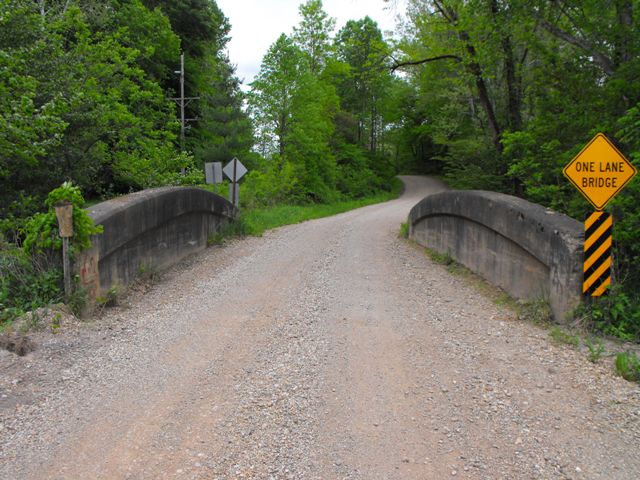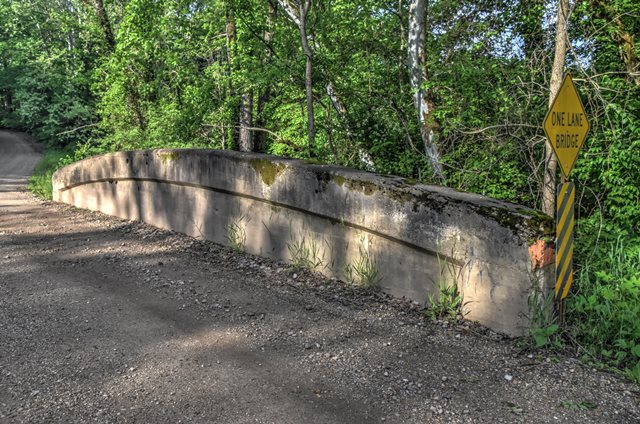We Recommend:
Bach Steel - Experts at historic truss bridge restoration.
BridgeHunter.com Phase 1 is released to the public! - Visit Now
CR-700 East Bridge
Parke County Bridge 106

Primary Photographer(s): Nathan Holth and Rick McOmber
Bridge Documented: May 8, 2010 and May 26, 2019
Rural: Parke County, Indiana: United States
1921 By Builder/Contractor: Unknown and Engineer/Design: R.J. Teague and C. Ott
Not Available or Not Applicable
40.0 Feet (12.2 Meters)
44.6 Feet (13.6 Meters)
18 Feet (5.49 Meters)
1 Main Span(s)
6100091

View Information About HSR Ratings
Bridge Documentation
View Archived National Bridge Inventory Report - Has Additional Details and Evaluation
This bridge is one of a handful of curved chord through girder bridges, sometimes called concrete camelback bridges, in Parke County. All of Parke County's surviving curved chord through girders should be considered historically and technologically significant. The bridges are historically significant because they represent the only surviving examples of this rare bridge type in Indiana. Further, only a select number of states in the country have any examples of this bridge type.
These concrete camelback bridges should be considered technologically significant as well. By incorporating a curve into the design, this not only increased the efficiency of the design, it also greatly increased the aesthetic value of the bridges. The graceful curves of this bridge type make them aesthetically pleasing. Straight chord through girder bridges are generally considered among the more plain and less visually appealing types of historic bridges. The aesthetic qualities of the curved girder bridge, those qualities being an integral and functional part of the bridge and not a decorative facade, should be considered to be a technologically significant feat: an effective union of function and form.
Most concrete through girders throughout the country including those with curved chords appear to have been limited to no more than 60 feet. Only Michigan, the undisputed leader in concrete curved chord through girders, appears to have regularly built curved chord through girders in excess of 60 feet in length with examples up to 90 feet. At 44 feet, this Parke County example is of average length for curved chord through girders outside of Michigan.
Unfortunately, Parke County's narrow-minded focus on the preservation of only its covered bridges with little to no recognition or preservation of other historic bridge types in the county has left these concrete camelback bridges ignored and suffering from a lack of preservation. Fortunately, the quality of construction in this bridge has allowed it to remain today in good condition despite the bridge not showing evidence of any repairs or rehabilitation over the years. Parke County has failed to post any interpretive signage for any of these historic concrete bridges, despite the fact that they are far more rare than covered bridges, both in Parke County and across the country. The covered bridges in the county, and even a couple metal truss bridges all have interpretive signage. HistoricBridges.org recommends that interpretive signage be installed for these concrete camelback bridges, and also recommends that rehabilitation projects be planned for these bridges to ensure their long-term existence.
This bridge is tagged with the following special condition(s): Unorganized Photos
![]()
Photo Galleries and Videos: CR-700 East Bridge
Bridge Photo-Documentation
Original / Full Size PhotosA collection of overview and detail photos. This gallery offers photos in the highest available resolution and file size in a touch-friendly popup viewer.
Alternatively, Browse Without Using Viewer
![]()
Bridge Photo-Documentation
Mobile Optimized PhotosA collection of overview and detail photos. This gallery features data-friendly, fast-loading photos in a touch-friendly popup viewer.
Alternatively, Browse Without Using Viewer
![]()
Additional Unorganized Photos
Original / Full Size PhotosA supplemental collection of photos that are from additional visit(s) to the bridge and have not been organized or captioned. This gallery offers photos in the highest available resolution and file size in a touch-friendly popup viewer.
Alternatively, Browse Without Using Viewer
![]()
Additional Unorganized Photos
Mobile Optimized PhotosA supplemental collection of photos that are from additional visit(s) to the bridge and have not been organized or captioned. This gallery features data-friendly, fast-loading photos in a touch-friendly popup viewer.
Alternatively, Browse Without Using Viewer
![]()
Maps and Links: CR-700 East Bridge
Coordinates (Latitude, Longitude):
Search For Additional Bridge Listings:
Bridgehunter.com: View listed bridges within 0.5 miles (0.8 kilometers) of this bridge.
Bridgehunter.com: View listed bridges within 10 miles (16 kilometers) of this bridge.
Additional Maps:
Google Streetview (If Available)
GeoHack (Additional Links and Coordinates)
Apple Maps (Via DuckDuckGo Search)
Apple Maps (Apple devices only)
Android: Open Location In Your Map or GPS App
Flickr Gallery (Find Nearby Photos)
Wikimedia Commons (Find Nearby Photos)
Directions Via Sygic For Android
Directions Via Sygic For iOS and Android Dolphin Browser
USGS National Map (United States Only)
Historical USGS Topo Maps (United States Only)
Historic Aerials (United States Only)
CalTopo Maps (United States Only)


